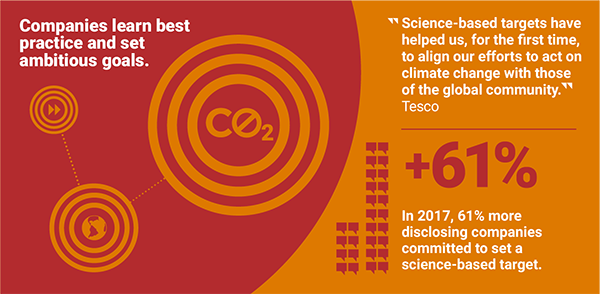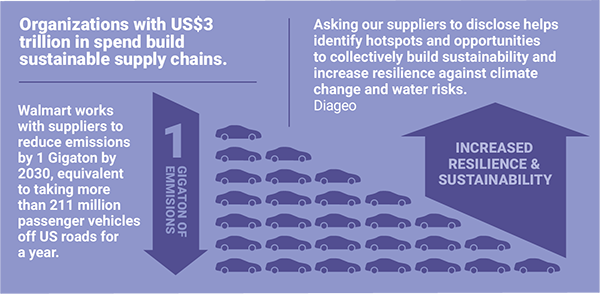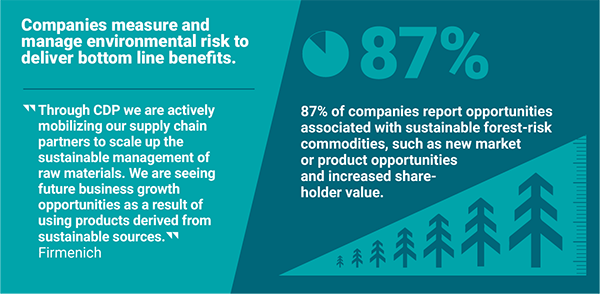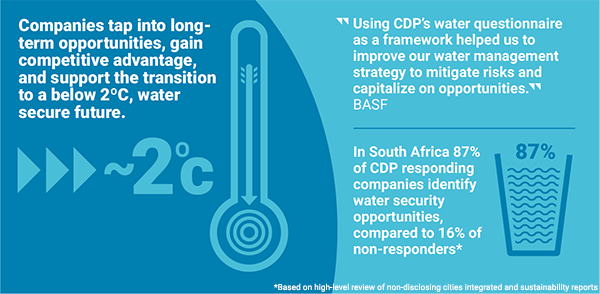CDP started, in 2000 with a simple, yet undeniable idea; transparency is the foundation for environmental action.
Despite being responsible for the majority of global emissions, back in the year 2000, many companies and investors had little concern for the impact of their pursuit of growth on the planet. Nor did they appreciate the very real threats that climate change and other environmental challenges would pose to their business.
We knew that the vital first step towards truly lasting action was getting these actors to measure and understand their impact. And with that, CDP, and the concept of environmental disclosure, was born.
We’ve come a long way in the last 18 years. Now some 6,300 companies disclose through CDP, along with over 570 cities and 100 states and regions. But for us, disclosure is the start, and over time we’ve also seen unprecedented action.
So what’s driving this change?
CDP’s data is shared across multiple investment platforms – including Bloomberg – as well as with over 100 top global purchasers. This means that by reporting to CDP, companies are able to show their investors, their buyers and their customers that they are preparing for the future, cutting costs and building resilience.
Reaping the rewards
With greater insight, these companies, cities, states and regions are increasingly recognizing the benefits of taking early action to tackle climate change, deforestation and water security, and the risks of continuing business as usual. And by sharing best practice, they are able to become leaders in their field.
In 2017, 73% of companies reporting to CDP on forests said they are committed to reduce or remove deforestation from their supply chains. Meanwhile 89% of companies now have emissions reduction targets in place, with a 61% rise in the number of companies aligning their targets with climate science.

Just this week, we saw the number of companies with science-based targets – those in line with or well below a 2C pathway - surpass 100, including the likes of McDonalds, L’Oréal and Tesco. Some 270 more are committed to following in their footsteps.
Meanwhile with some 100 major purchasers such as Bank of America, BT Group, Nestlé and Unilever asking their suppliers to disclose environmental information, we are seeing companies collectively build sustainability and resilience across their value chain.
Take for example Walmart: working with their suppliers to reduce emissions by 1 Gigaton by 2030, they will have the same impact as taking 211 million passengers vehicles off US roads for one year.

At the same time, companies are investing some US$23.4 billion across more than 1,000 projects across 91 countries to tackle water risks, as they look to increase water security.
And we’re not only seeing action by corporates. Over the last six years, we’ve seen a 20-fold increase in the number of climate related activities in cities.
Bottom line benefits
And while many report the environmental results it is the multitude of business benefits that are really driving momentum.
For example, suppliers reporting to CDP have seen a collective saving of around $14 billion from emission reduction activities, showing that cutting emissions doesn’t have to cost the earth.
Meanwhile 87% of companies reporting on forests see business opportunities from sustainable forest-risk commodities, such as new market opportunities and increased shareholder value.

Companies increasingly impacted by water insecurity are also using their reporting process to identify tactical initiatives to manage water security and mitigate risk. In South Africa, for example, in 2015, 87% of disclosing companies identified water security opportunities, compared to just 16% of non-disclosing companies (based on a high-level review of their integrated and sustainability reports).

The road ahead
But while Earth Day is an important day to celebrate how far we have come, it is also an important day to take stock of the work that still needs to be done.
It has never been more vital or urgent to take action. Some two billion people are already living in countries with high water stress, and greenhouse gas emissions and biodiversity loss must both peak around 2020 in order to avoid catastrophic disruption.
Our vision is for a sustainable economy that works for both people and planet. To get there is no small task.
We will need climate change, deforestation and water security to underpin every decision that companies, cities, states and regions and investors make and to be squarely on the agenda of every boardroom, mayor and governor’s office.
We need to see a decoupling of growth from the unstable use of our natural resources and the rise of carbon emissions, and we need to unlock trillions of dollars in investment in low-carbon, environmentally sustainable solutions. Ultimately we need to create a model of growth that generates returns today without compromising the needs of the future.
The time is now
There has also never been a better time to increase our collective ambition. The landmark Paris Agreement and the UN’s Sustainable Development Goals have put environmental action at the top of the international agenda.
Meanwhile, armed with ever more insight into their environmental impact and the opportunities of action, companies, investors cities, states and regions have never been in a better position to act.
We are inspired by the growing momentum behind environmental action. The world is undergoing a fundamental transition and at CDP we are dedicated to tracking the global economy’s shift towards a sustainable future, and providing the tools and the confidence to further raise our collective ambition.
Together we can transform the pace and scale of this global transition.
